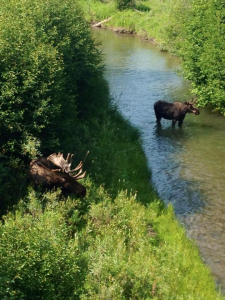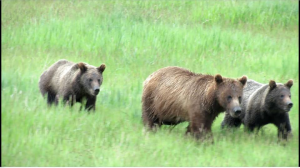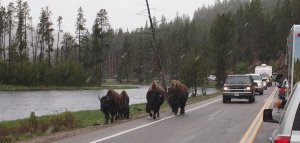National Park Wildlife. Wild or Not?
 Many visitors to Yellowstone and Grand Teton National Parks comment that the wildlife seem so comfortable with human presence. How does this happen? Does that still mean the wildlife in the parks are wild? And how should we respond to this behavior?
Many visitors to Yellowstone and Grand Teton National Parks comment that the wildlife seem so comfortable with human presence. How does this happen? Does that still mean the wildlife in the parks are wild? And how should we respond to this behavior?
We have all heard the expression “Monkey see monkey do,” but it is not just monkeys who learn in this fashion. Just this year, our tour groups have observed a mother grizzly teaching her cubs how to look both ways before crossing a road, and a mature moose teaching an adolescent how to deal with the tourist “paparazzi” (CHARGE!) Animals like this teach through modeling. They model the behavior that was either modeled for them, or has simply been working well for them so far. Perhaps Mama Griz had a couple close calls with traffic zipping by and has become wary of cars. Her cubs observe her pausing at the roadside, and only crossing when no cars are in sight. They see this behavior as normal, and adopt it for themselves. The older moose has seen hundreds, maybe thousands of visitors before. They have never approached or harmed him, so he tolerates their presence and sees no threat. Soon the young moose will feel the same toward camera flashes and crowds, just like the celebrity he is!
 But grizzlies that look both ways before crossing the street and moose that pose for photographers do not sound like wild animals! That may be true, but it is not just a single behavior that makes an animal wild or tame, it is their entire life cycle and all of their behaviors combined. Along with crossing the road, Mama Griz is teaching her cubs to find food seasonally – elk in the spring, flowers and roots in the summer, berries and nuts in the fall. Along the way, they will learn to avoid predators, swim, hunt, and find winter shelter. Their entire lives will be lived in the wilderness, wilderness that contains human visitors, but un-caged expanses nonetheless. The moose may ignore the photographers, but that is only because he has learned that they are harmless. As long as the photographers stay their requisite 25 yards away, he munches away – knowing humans are neither threat nor competition.
But grizzlies that look both ways before crossing the street and moose that pose for photographers do not sound like wild animals! That may be true, but it is not just a single behavior that makes an animal wild or tame, it is their entire life cycle and all of their behaviors combined. Along with crossing the road, Mama Griz is teaching her cubs to find food seasonally – elk in the spring, flowers and roots in the summer, berries and nuts in the fall. Along the way, they will learn to avoid predators, swim, hunt, and find winter shelter. Their entire lives will be lived in the wilderness, wilderness that contains human visitors, but un-caged expanses nonetheless. The moose may ignore the photographers, but that is only because he has learned that they are harmless. As long as the photographers stay their requisite 25 yards away, he munches away – knowing humans are neither threat nor competition.
 When animals behave so calmly toward us, we may assume tame-ness, or at least safety, but this is a false sense of security. Animals have what is called a “flight response distance,” or the distance at which they perceive danger and flee (or fight!) Over time, harmless encounters with tourists have decreased the flight response distance of many animals, making close encounters with wildlife possible and often thrilling. For example, bison in Yellowstone are frequently observed so close to cars that one could (but shouldn’t!) reach out and touch one. Also keep in mind that the distance at which an animal feels comfortable being observed may change from individual to individual, and for each encounter. Different activities such as mating , foraging for food, and raising and protecting young can cause animals to be stressed, and therefore more protective and prone to erratic behavior. Just because an animal was comfortable being watched yesterday, may not translate into today. As wildlife watchers we must be careful to respect the distances at which animals feel comfortable, both for their wellbeing and for our safety. In the national parks, when outside of a vehicle, National Park policy distance is set at 25 yards for most wildlife, and 100 yards (the length of a football field!) for bears and wolves or any animal acting aggressively. And when observing animals within these distances from a vehicle, windows should be rolled up with hands and cameras inside.
When animals behave so calmly toward us, we may assume tame-ness, or at least safety, but this is a false sense of security. Animals have what is called a “flight response distance,” or the distance at which they perceive danger and flee (or fight!) Over time, harmless encounters with tourists have decreased the flight response distance of many animals, making close encounters with wildlife possible and often thrilling. For example, bison in Yellowstone are frequently observed so close to cars that one could (but shouldn’t!) reach out and touch one. Also keep in mind that the distance at which an animal feels comfortable being observed may change from individual to individual, and for each encounter. Different activities such as mating , foraging for food, and raising and protecting young can cause animals to be stressed, and therefore more protective and prone to erratic behavior. Just because an animal was comfortable being watched yesterday, may not translate into today. As wildlife watchers we must be careful to respect the distances at which animals feel comfortable, both for their wellbeing and for our safety. In the national parks, when outside of a vehicle, National Park policy distance is set at 25 yards for most wildlife, and 100 yards (the length of a football field!) for bears and wolves or any animal acting aggressively. And when observing animals within these distances from a vehicle, windows should be rolled up with hands and cameras inside.
In Yellowstone and Grand Teton National Parks, we are so grateful to have the amazing wildlife watching opportunities that we do. Respect the wildlife, stay safe, and have fun!
Karyn Greenwood, Buffalo Roam Tours Guide


